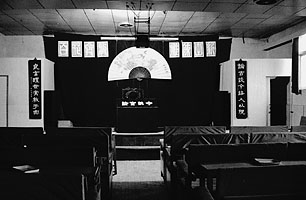History and Milieu (13)

Great Enlightenment Storytellers' House
Great Enlightenment Storytellersí House Da guangming shuchang was opened in 1987, after the remaining old storytellers' houses of Jiaochang had all closed at the beginning of the Cultural Revolution. Before 1990 the performance of Yangzhou pinghua and Yangzhou tanci took place in the main hall, seating more than 500 people.
The illuminated stage was placed in the middle of the high-ceilinged hall, where a sombre half-light reigned. The storyteller's table was furnished with a red tablecloth and a microphone. The audience occupied long wooden benches arranged in amphitheatre fashion. The majority were elderly male, but elderly women were also frequent customers, and middle aged of both sexes could be seen. Daily sessions of storytelling took place from 2-4 pm. A storyteller would be hired to perform a cyclus of tales taking up 2-3 months of daily performances. The hall was regularly used for other purposes, such as dancing.
In the beginning of the 1990s, the main hall was taken over completely for other activities, and Yangzhou storytelling and storysinging had been moved to a smaller room on the second floor. This place was lighter, seemed better isolated and neater. The wooden benches had been exchanged for upholstered seats with backs, but the capacity could not be much more than 150 people at most. In this room there were daily storytelling sessions in the afternoon, each storyteller performing a cyclus lasting several months.
The wall behind the stage in the new room was covered with large red drapery, adorned with the slogan of 'Let a hundred flowers bloom! Let the old be weeded through to bring forth the new!' bai hua qi fang, tui chen chu xin together with a large picture of a fan and a pipa, symbols of the performed arts quyi. On each side of the drapery there was a wooden tablet with the antithetical couplets:
Lun gu tan jin, hui ren yi gui
Liang yan xing shi, yu jiao yu le
Contemplating the past and telling about the present,
teaching so as to advise!
Good words to enlighten the world,
instruction infused in amusement!
These tablets were, of course, made in imitation of the old tablets at the entrance of the storytellers' houses of former times.
Outside the main door of Da guangming shuchang, the current programme was advertised, not on the traditional red scrolls, but on a large frame of white paper, written in fancy characters.
Storytellers house video (mpeg 9.003Kb)
Storytellers house video (wmv 2.777Kb)
Next: The storytelling event today